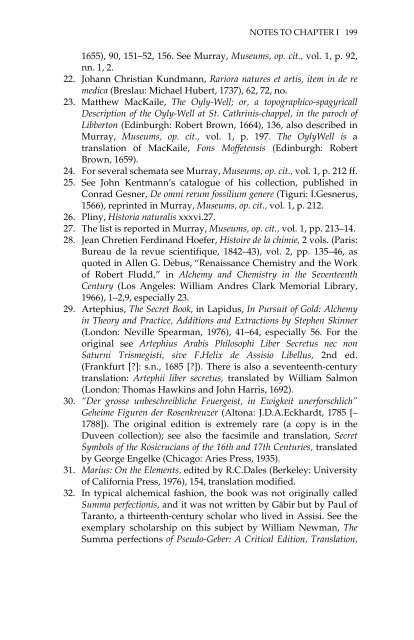What Painting Is: How to Think about Oil Painting ... - Victoria Vesna
What Painting Is: How to Think about Oil Painting ... - Victoria Vesna
What Painting Is: How to Think about Oil Painting ... - Victoria Vesna
Create successful ePaper yourself
Turn your PDF publications into a flip-book with our unique Google optimized e-Paper software.
NOTES TO CHAPTER I 199<br />
1655), 90, 151–52, 156. See Murray, Museums, op. cit., vol. 1, p. 92,<br />
nn. 1, 2.<br />
22. Johann Christian Kundmann, Rariora natures et artis, item in de re<br />
medica (Breslau: Michael Hubert, 1737), 62, 72, no.<br />
23. Matthew MacKaile, The Oyly-Well; or, a <strong>to</strong>pographico-spagyricall<br />
Description of the Oyly-Well at St. Cathrinis-chappel, in the paroch of<br />
Libber<strong>to</strong>n (Edinburgh: Robert Brown, 1664), 136, also described in<br />
Murray, Museums, op. cit., vol. 1, p. 197. The OylyWell is a<br />
translation of MacKaile, Fons Moffetensis (Edinburgh: Robert<br />
Brown, 1659).<br />
24. For several schemata see Murray, Museums, op. cit., vol. 1, p. 212 ff.<br />
25. See John Kentmann’s catalogue of his collection, published in<br />
Conrad Gesner, De omni rerum fossilium genere (Tiguri: I.Gesnerus,<br />
1566), reprinted in Murray, Museums, op. cit., vol. 1, p. 212.<br />
26. Pliny, His<strong>to</strong>ria naturalis xxxvi.27.<br />
27. The list is reported in Murray, Museums, op. cit., vol. 1, pp. 213–14.<br />
28. Jean Chretien Ferdinand Hoefer, His<strong>to</strong>ire de la chimie, 2 vols. (Paris:<br />
Bureau de la revue scientifique, 1842–43), vol. 2, pp. 135–46, as<br />
quoted in Allen G. Debus, “Renaissance Chemistry and the Work<br />
of Robert Fludd,” in Alchemy and Chemistry in the Seventeenth<br />
Century (Los Angeles: William Andres Clark Memorial Library,<br />
1966), 1–2,9, especially 23.<br />
29. Artephius, The Secret Book, in Lapidus, In Pursuit of Gold: Alchemy<br />
in Theory and Practice, Additions and Extractions by Stephen Skinner<br />
(London: Neville Spearman, 1976), 41–64, especially 56. For the<br />
original see Artephius Arabis Philosophi Liber Secretus nec non<br />
Saturni Trismegisti, sive F.Helix de Assisio Libellus, 2nd ed.<br />
(Frankfurt [?]: s.n., 1685 [?]). There is also a seventeenth-century<br />
translation: Artephii liber secretus, translated by William Salmon<br />
(London: Thomas Hawkins and John Harris, 1692).<br />
30. “Der grosse unbeschreibliche Feuergeist, in Ewigkeit unerforschlich”<br />
Geheime Figuren der Rosenkreuzer (Al<strong>to</strong>na: J.D.A.Eckhardt, 1785 [–<br />
1788]). The original edition is extremely rare (a copy is in the<br />
Duveen collection); see also the facsimile and translation, Secret<br />
Symbols of the Rosicrucians of the 16th and 17th Centuries, translated<br />
by George Engelke (Chicago: Aries Press, 1935).<br />
31. Marius: On the Elements, edited by R.C.Dales (Berkeley: University<br />
of California Press, 1976), 154, translation modified.<br />
32. In typical alchemical fashion, the book was not originally called<br />
Summa perfectionis, and it was not written by Gābir but by Paul of<br />
Taran<strong>to</strong>, a thirteenth-century scholar who lived in Assisi. See the<br />
exemplary scholarship on this subject by William Newman, The<br />
Summa perfections of Pseudo-Geber: A Critical Edition, Translation,


